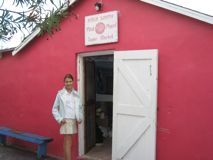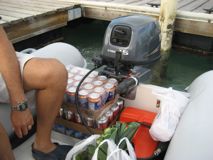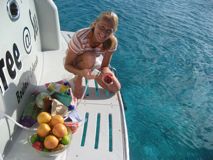Publish Date: Saturday, January 17, 2009
Location: Georgetown, Great Exuma Island, Exumas, Bahamas
Coordinates: 23° 30.767′ N 75° 44.725′ W
Boy was I a “newbie”! For those of you who read my November blog on provisioning, here’s the
follow-up. The answer for what to bring is…. everything you possibly can! This is particularly true in the Bahamas. Food is very expensive here, with limited availability. Examples:
-$7.25 for a medium size bag of tortilla chips
-$7.50 for a box of Keebler Gingersnap cookies
-$3 per grapefruit
-$15 for a bottle of Teriyaki Sauce
-$9 for a jar of jam
-$4-6 for a bottle of beer (at the store, not a bar)
I think you get the picture. Also the supply is highly variable. We went weeks with out being able to find any fresh milk or produce (other than potatoes and onions). Many items at the small markets are long past their expiration dates. I inadvertently bought some popcorn that had expired in March of 2007. Can you imagine when that must have been made? I’ve seen cream cheese and other dairy items with expiration dates in early 2008. These islands are remote and inhospitable to agriculture, due to sandy soil and salt air. Therefore most food is imported, with the Bahamian government applying high import taxes on items.
The cruising friends we have made here all chuckle with a knowing smile when I ask about what they brought. Everyone agrees, they fill every possible inch of storage space with provisions when cruising in the Bahamas. They plan their menus for six months at a time and provision accordingly. I have one friend whose freezer contains 26 beautiful pork tenderloins (one for each week of their trip) along with lots of other items too. If you fish, the waters are bountiful and can provide many excellent meals of lobsters, snapper, grouper etc. The only consistent local produce are onions and potatoes, with the occasional banana or tomato available. You can buy some frozen vegetables here, but I have not seen frozen fruit any where.
Cases of beverages (beer, soda etc) and snacks (chips, nuts, chocolate) fill every available nook and cranny on most boats. I was under the very mistaken impression that you could only bring 2 bottles of wine or alcohol per person into the country. Apparently this is true if you are flying into the country, but a very different set of rules apply to “ships stores”. Live and learn.
Having said this, you do get creative with what is available and we have had plenty of excellent meals. I cook far more on the boat than I did at home, and we eat out less than expected due in part to high prices and limited food choices. We probably eat one dinner and one lunch out each week.
The provisioning options in Georgetown have been excellent (relatively speaking) with plenty of produce available. I have loaded up our “ships stores” with canned beans, rice, pasta, tomato sauce, spices, coconut milk, peanut butter, granola bars and baking materials. The freezer is full of chicken, hamburger and frozen vegetables. I have been truly pleased that we brought our bread machine, as a loaf of warm bread makes any meal better (plus, it’s good for bartering or gifts for fellow cruisers).
Also, you must remember when buying more than just a few bags of groceries, you don’t have a
shopping cart you wheel out to the car, and then pull into your garage at home. You need to be able to carry everything you’ve bought to the dingy dock, secure it on the dingy and then get it back to the boat. Once on the boat, all groceries wait on the swim platform until produce is thoroughly washed, and most items are taken out of any type of cardboard box. A super vigilant program about what you bring on to the boat can help prevent any type of insect infestation (for instance, cockroaches lay their eggs in corrugated boxes, as well as some paperboard). So remember, the more you provision in the U.S. the less time you spend doing this drill in the Bahamas.


